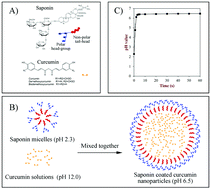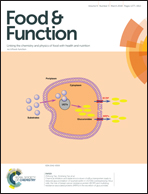Improving curcumin solubility and bioavailability by encapsulation in saponin-coated curcumin nanoparticles prepared using a simple pH-driven loading method
Abstract
Curcumin is a bioactive phytochemical that can be utilized as a nutraceutical or pharmaceutical in functional foods, supplements, and medicines. However, the application of curcumin as a nutraceutical in commercial food and beverage products is currently limited by its low water-solubility, chemical instability, and poor oral bioavailability. In this study, all-natural colloidal delivery systems were developed to overcome these challenges, which consisted of saponin-coated curcumin nanoparticles formed using a pH-driven loading method. The physicochemical and structural properties of the curcumin nanoparticles formed using this process were characterized, including particle size distribution, surface potential, morphology, encapsulation efficiency, and loading capacity. Fourier transform infrared spectroscopy and X-ray diffraction indicated that curcumin was present in the nanoparticles in an amorphous form. The curcumin nanoparticles were unstable to aggregation at low pH values (<3) and high NaCl concentrations (>200 mM), which was attributed to a reduction in electrostatic repulsion between them. However, they were stable at higher pH values (3 to 8) and lower NaCl levels (0 to 200 mM), due to a stronger electrostatic repulsion between them. They also exhibited good stability during refrigerated storage (4 °C) or after conversion into a powdered form (lyophilized). A simulated gastrointestinal tract study demonstrated that the in vitro bioaccessibility was around 3.3-fold higher for curcumin nanoparticles than for free curcumin. Furthermore, oral administration to Sprague Dawley rats indicated that the in vivo bioavailability was around 8.9-fold higher for curcumin nanoparticles than for free curcumin. These results have important implications for the development of curcumin-enriched functional foods, supplements, and drugs.



 Please wait while we load your content...
Please wait while we load your content...
